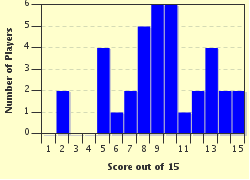Quiz Answer Key and Fun Facts
1. The first permanent settlement of the city that is now known as Paris was called Lucotocia by the Parissi tribe who lived there. What does Lucotocia mean?
2. Christianity was brought to Paris in the 3rd century which patron of the city who is said to have carried his head for miles after being beheaded?
3. Who was the Viking invader who unsuccessfully tried to invade Paris several times in the 880s?
4. Originally completed in 1202 as a fortress, the Louvre was built by which French king?
5. Jacques de Molay, who was burned at the stake in Paris on March 18, 1314, belonged to which organization?
6. Which famous Parisian building or structure was built in 1370 for use during the Hundred Years' War?
7. During the late 16th century, France and Paris was plagued by the French Wars of Religion. The last battle of the war was called the War of the Three Henrys. Which of the following is NOT one of the three Henrys?
8. Which French playwright opened the Illustre Theatre in Paris in 1643?
9. On May 30, 1770, 132 people died during a fireworks accident at what event?
10. The 1783 Treaty of Paris signaled the official end of which war?
11. On October 5, 1789, the Women's March on Versailles occurred. The lower class women stormed the Palace of Versailles in protest at the high price of what?
12. The Vendome Column, which was completed in 1810, was constructed to commemorate Napoleon's victory at what battle?
13. When it opened in 1889, the Eiffel Tower was the tallest man-made structure in the world. Which group of people opposed the Eiffel Tower initially?
14. Where in Paris were Jean-Marie Arthus and Pierre Benoit murdered on February 8, 1943?
15. What is the name of the satirical magazine whose headquarters was attacked by Al-Qaeda affiliates on January 7, 2015?
Source: Author
Joepetz
This quiz was reviewed by FunTrivia editor
bloomsby before going online.
Any errors found in FunTrivia content are routinely corrected through our feedback system.

